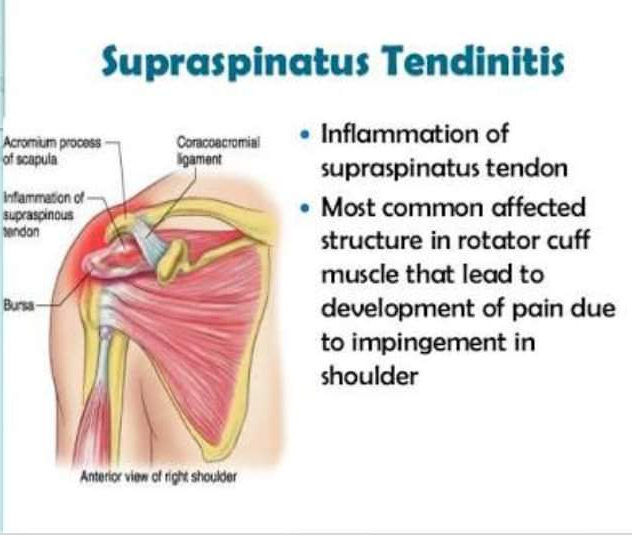
2024-07-26T01:53:22
Physiotherapy clinic in Tambaram Are you Looking for Physiotherapy Treatment in Tambaram, Sunshine Super Speciality Physiotherapy Clinic, We Provide Electrotherapy, Exercise and Manual Therapy, Orthopedic, Neuro, Cardio, Pediatric, Sports and Geriatric Rehabilitation, Post Operative Physiotherapy Treatment, Fracture Rehabilitation, pain free movement. #Supraspinatus #tendinitis is often associated with Subacromial Impingement Syndrome, Shoulder Impingement Syndrome, or Rotator Cuff Tendinitis. Inflammation of the tendon of the supraspinatus muscle leads to supraspinatus tendinitis. This is the most common cause of shoulder pain. The supraspinatus, infraspinatus, teres minor and subscapularis muscles comprise the rotator cuff muscle group. The main role of these muscles is stabilization of the humeral head in the glenoid fossa. Tendons of teres minor, supraspinatus, and infraspinatus insert on the greater tuberosity of the humerus, and subscapularis tendon inserts on lesser humeral tuberosity. Actions of these muscles are internal rotation (subscapularis), external rotation (teres minor and infraspinatus) and early abduction from 0˚ to 30˚ (supraspinatus). The subacromial bursa lies between supraspinatus tendon and the acromion. 👉#Indications Supraspinatus tendonitis can be caused by #extrinsic and #intrinsic factors. Extrinsic factors are divided into primary and secondary impingement. Increased subacromial loading, overhead activities, or trauma can cause primary impingement. Rotator cuff overload and muscle imbalance can cause secondary impingement. Supraspinatus tendonitis can also occur because of the decrease in the supraspinatus outlet space due to underlying instability of the glenohumeral joint. The supraspinatus outlet is a space formed by the acromion, acromioclavicular joint, and coracoacromial arch. The supraspinatus tendon runs through this outlet. Any abnormalities of this outlet can cause impingement of the supraspinatus tendon. 👉Incidence Prevalence In patients younger than 40 years of age, Supraspinatus Tendinitis occurs usually due to glenohumeral instability, acromioclavicular joint disease, or trauma. Patients older than 40 years of age, experience Supraspinatus Tendinitis mostly due to degenerative joint disease, glenohumeral impingement syndrome, or rotator cuff disease. Most at risk for Supraspinatus Tendinitis are people whose job requires repetitive overhead motions and athletes who compete in sorts such as swimming, throwing sports, volleyball etc. 👉Clinical Presentation Patients with Supraspinatus Tendinitis present with shoulder pain with movement and pain at night. They will also show weakness in the shoulder and arm. There is also possibility of tenderness and swelling in the upper front part of the shoulder and in some severe cases, difficulty to raise the arm to shoulder level. #Positive #Neer’s, #Hawkins-Kennedy, and #Empty Can Test indicate Supraspinatus Tendinitis. Patients also present with painful arc between 60o and 120o of shoulder abduction. 👉Potential Etiologies The impingement syndrome is the most common cause of supraspinatus tendinitis. Weakness and dysfunction of the rotator cuff muscles leads to elevation of the humeral head during arm abduction which causes compression of the tissues under the acromion process. Edema and hemorrhage of the supraspinatus tendon occur which can eventually lead to the tendon degeneration and rupture. Other causes of supraspinatus tendinitis include calcific tendinitis, trauma, crystal deposition, infection, or autoimmune conditions. 👉 Evaluation Special Orthopedic Tests Neer’s, Hawkins-Kennedy, and Empty Can Test are used to determine if patient has Supraspinatus Tendinitis. 👉Neer’s Test is performed with patient seated. Physical therapist passively elevates patients arm and then medially rotates the arm. Pain indicates a positive sign. 👉Hawkins-Kennedy Test is also performed with patient in seated position. Therapist passively moves patients arm to 90o of shoulder flexion and 90o of elbow flexion. Arm is the medially rotated and moved in different angles of flexion or horizontal abduction. Pain indicates a positive sign. 👉Empty Can Test is performed with patient seated. Arms are abducted to 90o, internally rotated, thumbs are pointed down, and arms are moved about 30o forward. Therapist then applies resistance to abduction. Weakness or pain is positive sign. 👉Conservative Treatment There are three phases during the treatment of Supraspinatus Tendiniti. SUNSHINE ® SUPER SPECIALITY PHYSIOTHERAPY CLINIC - #DrParthiban #Sunshinephysioclinic.in #Physiotherapyclinicintambaram #Physiotherapyclinicnearme DR.M.P. PARTHIBAN.M.P.T (Ortho), Chief Orthopedic Physiotherapist, Call for Appointments: - 9345122177 East Tambaram, CHENNAI

